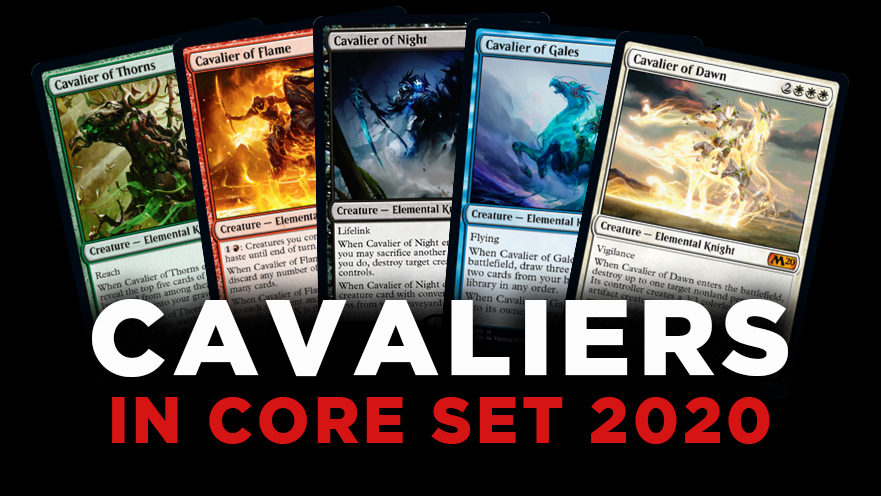The headlining mythic cycle of Core Set 2020 revolves around five different Cavaliers, one for each color. It’s common practice for Magic to have a cycle of creatures or spells headline their set, and it’s certainly not new with Core Sets. These creatures have some unique qualities and a ton of rules text, so let’s break them down and see how they work from a card design perspective.
We’re Not So Different, You and I
All cycles of Magic cards exist on a spectrum, from loose (very little in common) to tight (pretty much the same thing with slight variations). Examples of far tight cycles include dual land cycles (Fetchlands, Painlands, Shocklands), while loose cycles include the new wedge Legends in Core 2020.
Where does that leave our Cavalier friends? Here’s what they have in common:
Name: Cavalier of [Noun]
Mana Cost: 2CCC*
Type: Creature
Subtype: Elemental Knight
Ability
Enters the battlefield trigger
Dies trigger
* C = one colored mana
This is a semi-tight cycle that we’re used to seeing in Magic sets. Each card has a combat keyword, an “enters the battlefield” trigger, and a “dies” trigger. What’s curious (and an example of great design, in my opinion) is that they have a “dies” trigger instead of a “leaves the battlefield” trigger. “Leaves the battlefield” triggers create opportunities for broken or just plain unfun card synergies (looking at you, Thragtusk).
Every Cavalier has two triggered abilities that work together. The “enters the battlefield” ability can help fuel the “dies” ability, which is a nice change of pace in these designs instead of just having the same ability on both. You can get all your value out of the card even if your creature gets destroyed right away, which helps limit the feel-bad moments and promotes tournament viability.
Each of the cards has something unique about them, so let’s look at them one by one.
Cavalier of Dawn
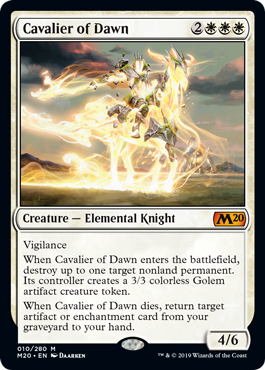
The most interesting thing about Cavalier of Dawn is its “enters the battlefield” ability. White typically has permanent-based removal, like Conclave Tribunal, which is ultimately temporary. Having a mostly color-shifted Beast Within is a pretty new effect in white; we’ve seen this type of effect on Generous Gift in Modern Horizons, but it’s never been used in Standard before (unless you count Baffling End, which has a similar effect). However, this effect is in the spirit of white, which always gives opponents Reparations for their troubles (“Sorry I burned down your village. Here’s some Gold”), and a five-mana creature is a great vehicle to try it.
Cavalier of Gales
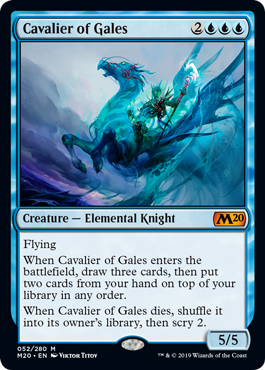
Brainstorming is always nice, but the most remarkable thing about Cavalier of Gales is its “dies” ability. This Cavalier goes back into your library after it dies, and it joins a long list of iconic spells that can cause headaches for opponents everywhere. While I don’t think that this will pose the same amount of issues as Nexus of Fate (mostly because you can still get rid of it without triggering the dies effect), this ability definitely made me perk up my ears. The “scry 2” is cute as well, especially if you can help you get the Cavalier back into your hand quickly.
Cavalier of Night
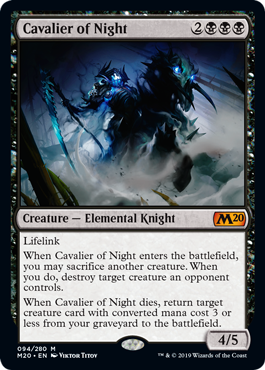
The most important word in this card’s rules text is “may”: “When Cavalier of Night enters the battlefield, you MAY sacrifice another creature. When you do, destroy target creature an opponent controls.” This added word helps prevent “feel-bad moments,” and we’ve been seeing optional effects like this more and more in card design. Earlier in Magic’s history, it would be a smart play to use this type of effect to sacrifice your creature to itself if your opponent got rid of all your other creatures. Now, the person casting the creature always gets a benefit and can have a 4/5 with lifelink no matter what.
Cavalier of Flame

Here’s where things get complicated. Cavalier of Flame is the only creature in this cycle that doesn’t have a static keyword ability; instead, it has an activated one. The most obvious keyword that red would get in a cycle would be haste (and this creature does have haste, if you activate its ability), but somehow, a 6/5 haste creature that lets you draw cards might have been just a little too good. An activated ability creatures design space for more effects – in this case, the Cavalier has “Super-firebreathing.” The result is a creature that doesn’t incentivize overly aggressive plays, but that still plays well in a creature-based strategy.
Cavalier of Thorns
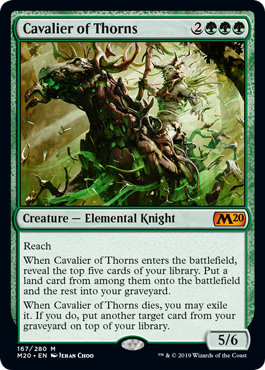
We end our cycle with a creature that seems like it went through a lot of tinkering during design. Like the rest, Cavalier of Thorns has two triggers play nicely with each other: a modified Mulch and a Reclaim. Wizards has been going away from printing tutoring effects on green creatures since Primeval Titan’s dominance, but digging five cards into your library feels fair.
The wording of Cavalier of Thorns’s “dies” trigger is also worth noting: “…you may exile it. If you do, put a card from your graveyard on top of your library.” While you can’t target the Cavalier with its own “dies” trigger, you could easily loop two Cavaliers if not for that exile clause. This Cavalier may have been much more powerful in early playtesting, but its current power level seems just right for Standard.
Leaves the Battlefield
Before we go, it’s worth noting that all five Cavaliers share the “Elemental Knight” creature type. The Elemental creature type is prevalent in Blue, Red, and Green in Core Set 2020, so you may get some cool special bonuses for playing these creatures in your Elemental deck. The Knight type is less relevant, though you could always brew up a Black/White deck for Standard before Dominaria rotates this fall.
Overall, this Cavalier cycle is compelling from a design perspective, as they do many things that creatures haven’t done before. Will they be good in Standard? Probably. Will they be good in Commander? Absolutely. Either way, these cards are worthy of a headlining cycle in a Core Set.

Robby Rothe, Jr., also known as MTG Color Pie, has played Magic since Revised and written about Magic design for more than 10 years. As a Melvin, he was one of the final 101 finalists for the Great Designer Search 2. Robby is also an unabashed Commander enthusiast and embraces the casual side of the game.

